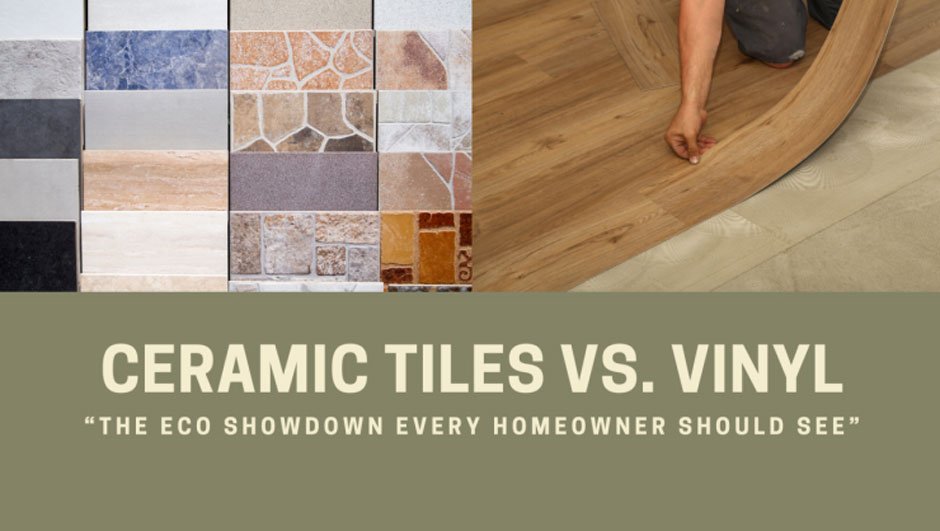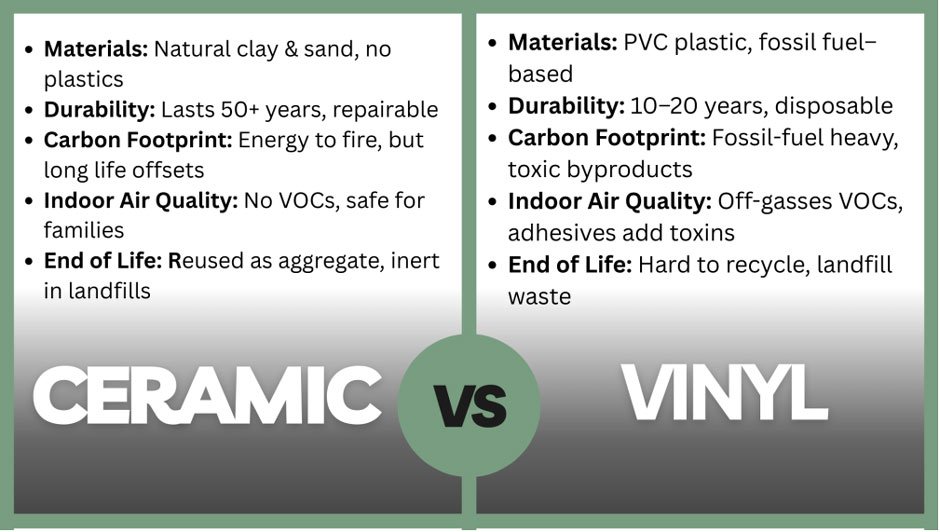
Talk about flooring, and most homeowners find themselves torn between cost, style, and sustainability. Vinyl has exploded in popularity thanks to its low price tag and trendy looks, but beneath the glossy marketing lies a less appealing truth: vinyl is one of the least eco-friendly flooring options on the market.
Ceramic tiles, on the other hand, have been around for centuries. They may not always be the first choice in an age of quick fixes, but when viewed through an environmental lens, they often emerge as the smarter, greener alternative.
So, which one really wins in the eco showdown? Let’s break it down.
1. Materials: Natural vs. Synthetic
- Ceramic tilesare made with clay, sand, and water, and abundant natural raw materials that don’t require heavy chemical synthesis to create. When you walk on ceramic, there’s no petroleum byproduct underfoot, no PVC hidden beneath the surface. Tiles are baked hard, yes, but at their essence they are made of the earth itself. There’s something inherently sustainable about using materials that can be taken, shaped, and returned without introducing plastics into the chain. Boutique and luxury-focused brands, such as the OUTERclé collection of ceramic tiles, are designed with sustainability in mind, showing how natural materials can also deliver high-end style.
- Vinyl flooring,by contrast, is a synthetic creation through and through. It comes from PVC (polyvinyl chloride)which is manufactured using petrochemicals. That means it depends on fossil fuels from its very origin. The production is not only resource-intensive, but it also creates toxic byproducts, including chlorine-based compounds, which are challenging to manage responsibly. Vinyl’s “low-cost” image has a hidden story: cheap at the checkout line, expensive if you calculate the true cost in environmental harm.
| Winner: Ceramic tiles: They come from natural, non-toxic origins, while vinyl represents the introduction of plastics into our most personal spaces. |
2. Durability: Built to Last vs. Built for Replacement
- The second point in the showdown is longevity. Ceramic tiles are tough; so tough that you’ll often see centuries-old terracotta or glazed tiles in European villas, still intact after generations of traffic. With proper installation and care, ceramic flooring can last 50 years or more. It shrugs off water damage, resists scratches from pet claws or chair legs, and maintains its look with minimal upkeep. Durability means not only fewer headaches for you, but also less waste going into landfills since you aren’t ripping out your flooring every decade.
- Vinyl flooring can feel sturdy at first, but it simply isn’t built with the same timeline in mind. Even the high-end luxury vinyl planks marketed today rarely last more than 10–20 years. They’re prone to dents from furniture legs, fading from sunlight exposure, and wear patterns in high-traffic areas. And unlike wood, which can sometimes be refinished, or ceramic, which can be cleaned and repaired tile by tile, vinyl has no second act. The only option when it wears out is removal and replacement. Durability alone makes it hard to call vinyl anything close to sustainable.
| Winner: Ceramic tiles: longevity makes them a true sustainable investment. |
3. Energy & Carbon Footprint
- Now, here’s where things get nuanced. Ceramic does demand a lot of energy up front. Tiles are fired in kilns that reach temperatures upward of 1,000 to 1,200°C. That baking process is unavoidable if you want a surface sturdy enough to last decades. But when you factor in that lifespan, the story shifts. Because a tiled floor doesn’t need replacing every 15 years, the overall carbon cost per year of use decreases dramatically. For homeowners who can source tiles from local or regional manufacturers instead of importing, transportation emissions can also be kept low.
- Vinyl’s picture is different. It doesn’t need kilns, but its carbon footprint is baked into its entire supply chain. From the refining of oil into petrochemicals, to the manufacture of PVC resins, to the blending with additives and stabilizers, vinyl carries fossil fuel dependency at every stage. And the carbon story doesn’t end when it’s made. At disposal, vinyl that ends up in incinerators may release dioxins, some of the most toxic compounds we know of, contributing further to air and soil pollution.
| Here, the verdict leans heavily toward ceramic again: yes, their initial energy use is significant, but their long life span and lower end-of-life pollution make them cleaner across decades. |
4. Indoor Air Quality & Health
- Many homeowners overlook indoor air quality when picking flooring, but it can have a huge impact on daily well-being. Ceramic tiles are stable and inert. Once installed, they don’t emit volatile organic compounds (VOCs) into the air. For households with children crawling on the floor, pets lounging around, or family members sensitive to allergies or asthma, that’s a quiet and lasting benefit.
- Vinyl flooring is another story. Being derived from PVC, it can off-gas VOCs, and many adhesives used during installation also release harmful chemicals for weeks or even months afterward. This creates an indoor air environment that can aggravate respiratory conditions or simply expose homeowners to toxins over the long term. While regulators have pressured vinyl manufacturers to limit harmful substances, the risks haven’t vanished.
| Winner: On health grounds, ceramic flooring is clearly the safer bet, and not just for people, but pets too |
5. End of Life: Recyclable vs. Non-Recyclable
- Eventually, no matter how durable, every floor reaches its end. What happens then makes a big sustainability difference. Ceramic, while not often recycled into brand-new tiles, at least has pathways for reuse. Crushed ceramic can be used in construction aggregates, roadbeds, or even as raw material in new building mixes. It may not turn back into flooring, but it doesn’t have to rot in a landfill.
- Vinyl, on the other hand, poses a nightmare. Its mixed composition of resins, stabilizers, and plasticizers makes it difficult to recycle in any practical, large-scale way. As a result, the overwhelming majority of vinyl flooring is either sent to landfills or incinerated. Once in landfills, some of its additives can leach out over time, creating persistent environmental hazards. At this stage, the supposed benefits of vinyl, its affordability and flashy looks have evaporated, leaving only problematic waste.
| Taken together, the end-of-life comparison puts ceramic far ahead of vinyl, especially when you think in terms of cumulative generational impact. |
The Hidden Cost of “Cheap” Vinyl
Vinyl may be budget-friendly upfront, but the hidden costs to the planet are steep. Frequent replacement, poor recyclability, and toxic production make it a flooring choice that homeowners, and future generations end up paying for in environmental damage.
Ceramic tiles might cost more initially, but their durability, safety, and natural makeup make them a far more sustainable option over time.
Takeaway for Homeowners

When it comes to flooring, the real choice isn’t just about color or cost. It’s about impact.
- Choose Vinyl and you’re opting for short-term savings with long-term environmental harm.
- Choose Ceramic and you’re investing in a greener home that’s healthier for your family and kinder to the planet.
🌱 In the eco showdown, ceramic tiles clearly take the crown.
For homeowners interested in longevity and environmental impact, our article on “The Lifecycle of Your Home: Designing for Durability, Repairability, and Reuse” offers great tips on choosing high-durability materials making ceramic tiles an even smarter long-term choice.
